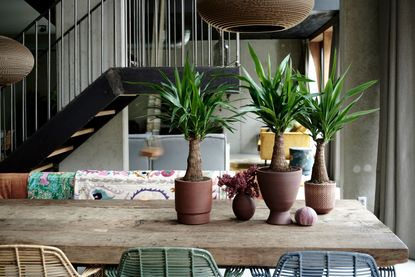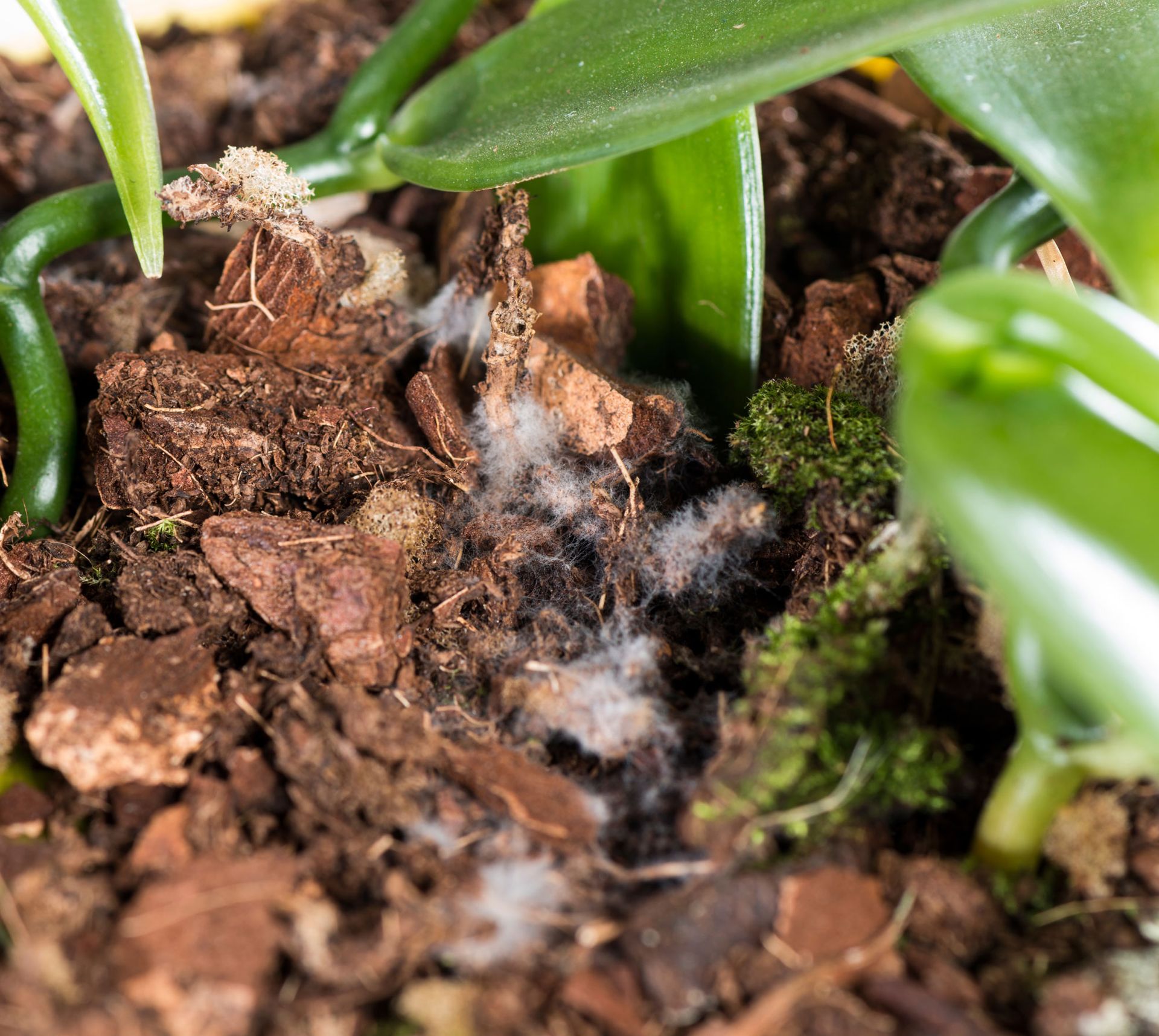How to treat mold on houseplant soil – from repotting to a sprinkle of cinnamon, experts offer their top hacks
If you've got mold on houseplant soil, it could be the harbinger of a more serious problem for your plant. Here's what it means, and what you can do to both prevent and get rid of it


Finding mold on houseplant soil can be a little alarming – after all, mold is usually a sign that something is past its best. On a houseplant, it's not necessarily a cause for alarm, but you should take action to keep your plant healthy and avoid any of the side effects that can come with moldy soil.
Mold is something that can happen to all kinds of houseplants, even the best houseplants for beginners. Understanding why this happens to a houseplant is half the battle when it comes to both treating mold and preventing it from happening in the first place. There are simple steps you can take to remove mold from plants, but if the problem persists, you may want to take more severe action.
Ignore the symptoms and it could spell the end of your houseplant, so learn how to treat mold on houseplant soil with our guide from the indoor gardening experts.
How to get rid of mold on houseplant soil
Mold on houseplant soil doesn't mean that your plant is dying – it's largely to do with how much moisture is in the soil. Here's a clue: it's too wet.
'If you notice mold growing on your houseplant's soil, it's not the end of the world,' explains Naomi Robinson of Houseplant Authority. 'This usually appears due to the potting mix being kept overly wet, whether that's due to excessive watering, poor drainage or a combination of the two.'
Get some guidance on how often you should water houseplants. Plus, organic matter, such as fallen leaves decaying, can also create the perfect environment for mold to thrive.
1. Move it to a new location
Take action when you first notice mold on a houseplant's soil to ensure your plant stays in best condition. Before you look at repotting the plant, first see if a change of location might help.
'If the mold is not too severe, you can try moving the plant into the sunlight,' suggests Matt Eddleston, founder of Gardening Vibe. 'This helps the soil to dry and kills mold at the same time. Removing decaying leaves and the top layer of soil along with the mold also helps to get rid of the problem.
2. Change the soil
'Otherwise, remove as much of the moldy soil as possible,' says Brody Hall of the Indoor Nursery. 'Indoor gardeners can do this by gently brushing the soil off the roots using their fingers, a small paintbrush, or an old toothbrush.'
'Clean your plant's container when doing so, ideally with some bleach, to ensure that you're not accidentally passing the contamination on to the new soil,' adds Naomi Robinson of Houseplant Authority.
3. Check the rest of the plant for mold
'You should also take a look at your plant's roots for rot when changing the soil, so any affected parts can be trimmed to stop them from spreading,' says Naomi Robinson.
Check the mold hasn't spread to the plant stem or leaves too. 'If the mold has already spread to the plant itself, you may need to trim away any affected leaves or stems,' says Stephen Webb of Garden's Whisper.
4. Treat the soil for mold
Changing the soil should solve the problem, especially if you take steps to prevent the mold from reappearing as outlined below, but if mold persists despite your best efforts, you can try a treatment to kill the mold, too.
'If the infestation persists, a commercial fungal spray will do the trick,' says Brody Hall. 'Or, if you’d like to stick to a natural product, use a sprinkle of cinnamon. It might sound strange, but cinnamon has natural anti-fungal properties that are an effective solution to mold.'

Mold can appear on houseplant soil as a white fuzz.
Will mold on soil harm my houseplant?
In itself, mold on your houseplant's soil isn't a direct risk to its health, however, it is a sign that your plant is enduring some less-than-ideal conditions.
'In most cases though, mold on your houseplant's soil isn't the worst problem that can happen to an overwatered plant, although it's a sign that you do need to make some adjustments,' says Naomi Robinson. 'This is especially to avoid the situation progressing to full-blown root rot, which can kill your plant.'
Mold can also be the source of another common houseplant problem - gnats. 'If you have soggy moldy soil due to standing water in your pots, you are creating the perfect gnat attractor,' explains Angelia Daugirda of Organic Plant Magic. Mold serves as the perfect habitat for nests of these annoying house pests.
How do I prevent mold from reappearing on houseplant soil?
'To avoid mold (and everything that can go with it), review your watering schedule to make sure you're only watering your houseplant when it's needed.,' suggests Houseplant Authority's Naomi Robinson. 'You may also want to check that the soil you're using is sufficiently well-draining.'
'To prevent overwatering that will cause mold to occur again, make sure that the top 1-2 inches of soil dry out completely between each watering,' suggests Ayelet Faerman of houseplant delivery brand VerdantLyfe.
You can also try the cinnamon trick when repotting your plant to keep mold at bay. 'Sprinkle a natural anti-fungal such as cinnamon or baking soda on top of the soil or add them to your potting mix,' suggests Matt Eddleston.
Keep the soil well ventilated, and drier, by moving your plant to an optimum location, too. 'Once you've removed all the moldy growth, keep the potting mix dry and well-ventilated to prevent mold from coming back. This may mean watering your plant less often or moving it to a brighter location,' suggest Stephen Webb.
Lastly, to prevent mold in houseplant soil, using healthy, commercial, sterile potting soil is key.
Be The First To Know
The Livingetc newsletter is your shortcut to the now and the next in home design. Subscribe today to receive a stunning free 200-page book of the best homes from around the world.

Hugh is the Editor of Livingetc.com. From working on a number of home, design and property publications and websites, including Grand Designs, ICON and specialist kitchen and bathroom magazines, Hugh has developed a passion for modern architecture, impactful interiors and green homes. Whether moonlighting as an interior decorator for private clients or renovating the Victorian terrace in Essex where he lives (DIYing as much of the work as possible), you’ll find that Hugh has an overarching fondness for luxurious minimalism, abstract shapes and all things beige. He’s just finished a kitchen and garden renovation, and has eyes set on a bathroom makeover for 2024.
-
 The 12 Best Table Lamps for Reading —I'm a Certified Bookworm (and Shopping Expert)
The 12 Best Table Lamps for Reading —I'm a Certified Bookworm (and Shopping Expert)When it comes to table lamps for reading, I don't mess around. If you're the same, this edit is for YOU (and your books, or course — and good recommendations?)
By Brigid Kennedy Published
-
 "It's Scandi Meets Californian-Cool" — The New Anthro Collab With Katie Hodges Hits Just the Right Style Note
"It's Scandi Meets Californian-Cool" — The New Anthro Collab With Katie Hodges Hits Just the Right Style NoteThe LA-based interior designer merges coastal cool with Scandinavian simplicity for a delightfully lived-in collection of elevated home furnishings
By Julia Demer Published

